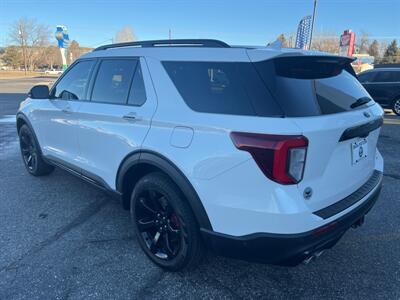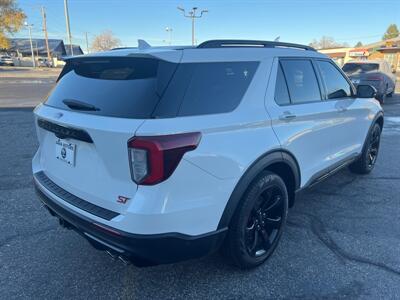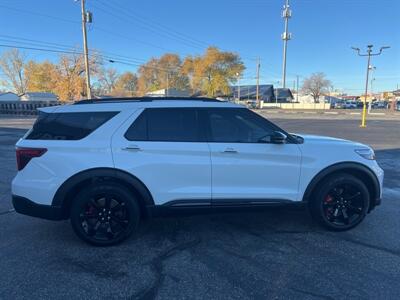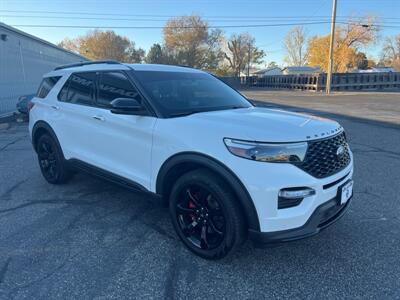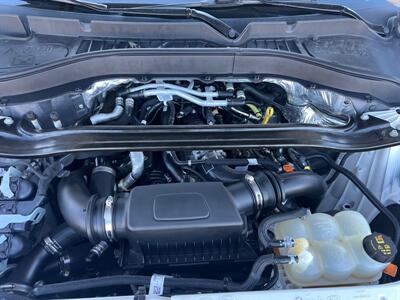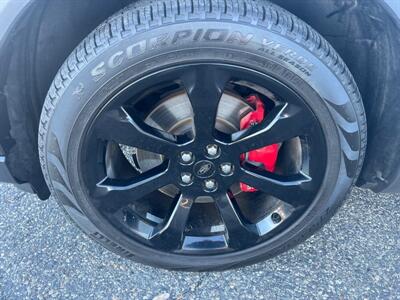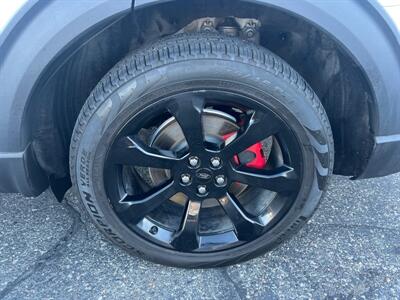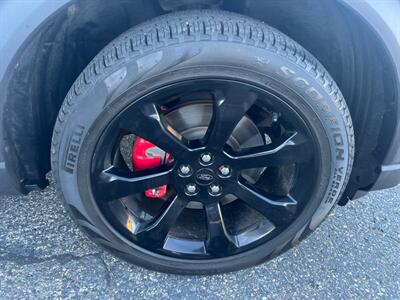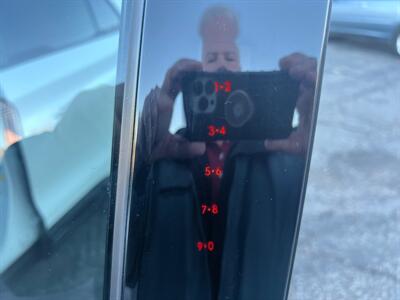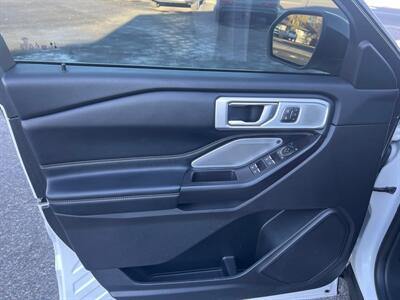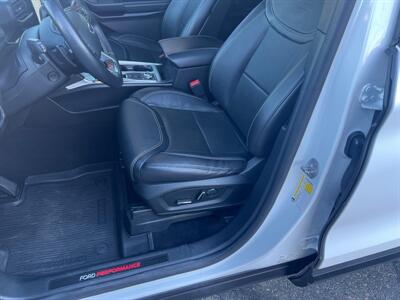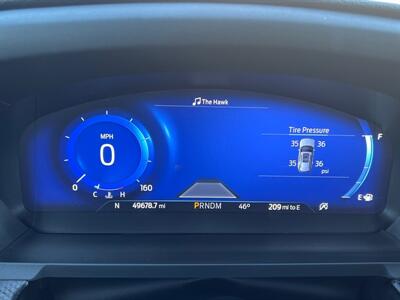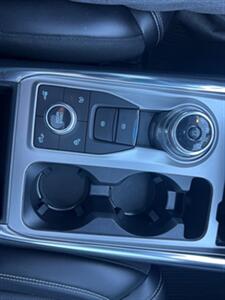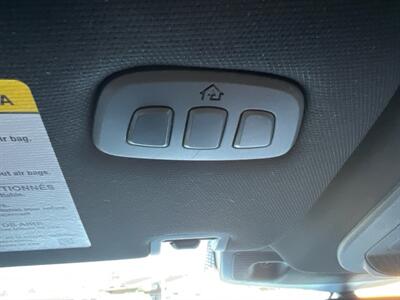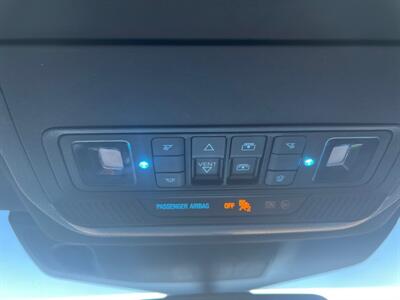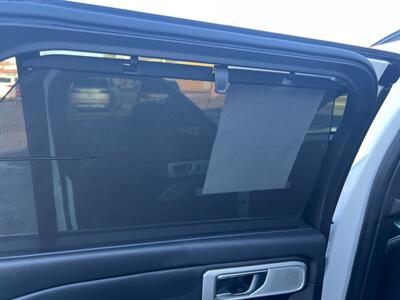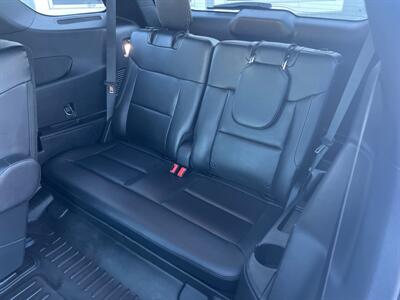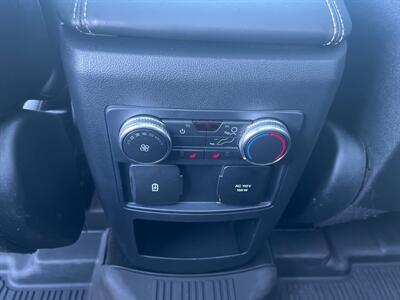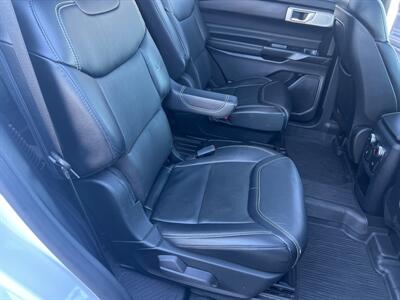2020 Ford Explorer ST for sale in Billings MT

AS REVIEWED BY EDMUNDS.COM
2020 Ford Explorer Review
byCameron Rogers
Manager, News
Cameron Rogers has worked in the automotive industry since 2013. He has tested and reviewed hundreds of vehicles over the course of his career. Today, he leads the news team in developing cutting-edge news articles, opinion pieces and sneak peeks at upcoming vehicles. Favorite cars that he's driven during his tenure at Edmunds include the 991-era Porsche 911 Turbo S, Rolls-Royce Ghost and several generations of Honda Odyssey (really).
Pros
- Strong engines for quick acceleration
- Rear-wheel-drive platform improves handling and towing
- Roomy cargo area
Cons
- Too much wind noise at highway speeds
- The price can get frighteningly expensive in a hurry
- Lackluster interior material quality
What's new
- The Ford Explorer is fully redesigned for 2020
- Part of the sixth Explorer generation introduced for 2020
Overview
It would be an understatement to say that the Ford Explorer is an important SUV. Before it debuted as a 1991 model, the family-oriented four-door sport-utility vehicle segment hardly existed at all. The Explorer formula turned out to be a huge success, and soon after everyone got into the game. We all know what happened after that.
Cost to DriveCost to drive estimates for the 2020 Ford Explorer 4dr SUV (2.3L 4cyl Turbo 10A) and comparison vehicles are based on 15,000 miles per year (with a mix of 55% city and 45% highway driving) and energy estimates of $3.08 per gallon for regular unleaded in Montana.
Monthly estimates based on costs in Montana$159/mo for Explorer Base
Explorer Base
vs
$220/mo
Avg. Large SUV
Calculate my fuel costs
Now entering its sixth generation, the 2020 Ford Explorer represents a complete rethink of this three-row family SUV. Early Explorers were built on truck frames and were primarily driven by the rear wheels, and the outgoing model employed a front-wheel-drive layout and used car-like unibody construction.
The all-new 2020 model combines the best elements of each. It returns to a rear-wheel-drive layout, but its body retains unibody construction. This detail isn't obvious at first because the new Explorer uses familiar styling cues that give it a strong family resemblance. These outward clues only hint at the transformative changes that lie hidden beneath the sheet metal.
The switch back to rear-wheel drive makes sense on numerous levels. Handling and overall balance improve dramatically when you stop trying to steer and power a vehicle from the same end. There are also benefits to towing stability and powertrain selection. The new Explorer comes with Ford's smooth and sturdy 10-speed automatic, for instance. And it certainly doesn't hurt that Ford was able to expand the interior room in the bargain.
There's a lot to like here, but it's not a grand slam home run. The new 2020 Ford Explorer rides, handles and accommodates passengers much better than the one it replaces, and it is dynamically superior to its crossover competition. The hybrid offers unexpected benefits that extend beyond fuel economy, too. But it can get expensive in a hurry, and the interior materials don't quite match the price. Overall, the Explorer merits close consideration but you should also check out other three-row SUV standouts such as the Honda Pilot and Kia Telluride.
Edmunds Expert Rating
Our VerdictThe Edmunds Vehicle Testing Team evaluates a fresh batch of vehicles every week, pairing objective assessments at our test track with real-world driving on city streets, freeways and winding roads. The data we gather results in our Expert Ratings. They’re based on 30-plus scores that cover every aspect of the automotive experience.Average
7.4
out of 10
edmunds TESTED
The Ford Explorer has uncommonly good balance and poise for a midsize three-row SUV. It's not the roomiest, but its standard infotainment and safety tech offerings are competitive. Two things hold it back: subpar materials quality and high pricing.
Rated for you by America's best test team.
Performance
8/10How does the Explorer drive? The Explorer is the three-row SUV to get if your priorities include balanced handling and strong acceleration. Unlike a lot of other SUVs in this class, it feels eager and light as you drive around turns. There's a lot of grip too.
The latest Explorer can handle lots of power, and Ford takes full advantage. The sturdy turbocharged four-cylinder base engine easily outpaces the competition. And there's a bonkers turbo V6 in the Explorer ST for those who believe too much is never enough. Both are helped along by a 10-speed transmission. It kicks down faithfully when you need it to, but in city traffic, when you're just lightly getting on and off the gas, its shifting is too indecisive.
Comfort
7/10How comfortable is the Explorer? The Explorer's front seats are nicely shaped and comfortable. But we don't recommend the optional massaging ones — the mechanism that makes them work can make them feel lumpy when they're off. Seat comfort gets progressively less cushiony as you move back to the second and third rows. Our Explorer Limited test vehicle rode smoothly most of the time, but smaller road imperfections were a little more noticeable than in some other SUVs.
Operating the automatic climate control system can require more manual adjustments than expected; the air vents won't pump out as much air as you want when you lower the temperature, for instance. Another drawback is that the Explorer isn't as quiet as it should be. The sound of the engine isn't well-masked, and you can hear gusty wind noises at even moderate highway speeds.
Interior
7.5/10How’s the interior? Things look decent from the driver's perspective. Front-seat space is abundant, and the driving position is nicely adjustable. It's generally easy to see out thanks to adequate glass area and good-size mirrors.
But middle- and rear-seat passengers aren't as well taken care of. Middle-row knee room and legroom are not up to the standard set by others in the class, and the third row is unlikely to impress taller-than-average adults. Rear door access can be clumsy if the doors can't be opened past the first detent because space is tight between the large door map pockets and the prominent rear wheel arches. The third-row power folding mechanism is nice, but raising the row for passengers must be done from the hatch area.
Technology
7.5/10How’s the tech? Every Explorer comes with an 8-inch touchscreen, the Sync 3 infotainment, and support for Apple CarPlay and Android Auto. The Limited comes with built-in navigation and a strong-sounding Bang & Olufsen premium audio system. Do not be tempted by the optional 10.1-inch vertical touchscreen. Its skinnier profile does not work well with Apple CarPlay, Android Auto and the display of the rearview camera.
The Explorer is well-equipped with driving safety aids. All Explorers come standard with automated emergency braking, lane keeping assistance, cross-traffic and blind-spot monitoring, and automatic high beams. The Limited also has adaptive cruise with lane centering. These systems work well. However, the alerts sound overly similar, and the lane centering system may falsely accuse you of taking your hands off the wheel.
Storage
8/10How’s the storage? The Explorer's cargo hold is generous. With the third-row seats up, it's a bit tighter than in some other SUVs, but you can still fit three or four rolling suitcases back there. There's a good amount of small-item storage up front for your odds and ends, and child seats are easy to install in the middle row.
The Explorer's rear-drive architecture makes it especially well-suited to towing, even if the rating of 5,000 pounds isn't particularly distinctive. The Trailer Tow package comes with an easily accessed receiver hitch, four- and seven-pin wiring, full support for an add-on electric trailer brake controller, a tow-haul transmission mode, and an enhanced blind-spot monitoring system that covers the length of the trailer.
Fuel Economy
7/10How’s the fuel economy? On paper, the 2.3-liter EcoBoost engine that powers the Base, XLT and Limited models is rated to return slightly better fuel economy than its closest competition. The rear-wheel-drive version is EPA-rated at 24 mpg combined, and the all-wheel-drive model is rated at 23 mpg combined. Depending on what you compare it to, that's generally 1 or 2 mpg better.
But we could not match these figures in practice, possibly because this turbocharged engine feels overeager. Our test average was 21.1 mpg, and that included a long stretch of freeway driving. This number lined up more or less exactly with lower-rated competitors that we drove in the same way.
Value
6/10Is the Explorer a good value? You don't have to look very far or very hard to see plasticky interior plastics, unsightly gaps and mediocre design details. These would be understandable if this vehicle was a bargain, but it's not. The competition's very well-equipped top-level models cost less than a lowly Explorer XLT with minimal options. What's more, the Explorer's stiffest competition offers stronger warranty coverage.
You'd have to be the sort who puts a high premium indeed on mountain road agility and powertrain performance to offset these drawbacks. On paper at least, the 2.3-liter EcoBoost will reward you with better fuel economy. But we found it hard to replicate the EPA ratings in the real world, and in our tests the Explorer came out no better than its rivals.
Wildcard
8/10You'll still peg the latest model as an Explorer, but this new one has a strong stance and sleek proportions that suggest motion. And this is no hollow promise because it offers a much better driving experience than any previous Explorer — or the majority of its competition. It's fast, it has poise and balance, and it likes to be hustled through corners. This Ford is the one to get if your daily drive includes mountain roads or interesting corners
Which Explorer does Edmunds recommend?
The Explorer is feature-rich throughout the lineup, but each trim up the ladder is substantially more expensive than the model below. With that in mind, we think the XLT provides a good number of creature comforts at a reasonable price. Unlike on the base trim, Ford also offers some optional packages for the XLT trim that give buyers more choice.2020 Ford Explorer models
The 2020 Ford Explorer is a three-row midsize SUV with seating for seven, or six if you opt for the second-row captain's chairs. The base model is well-equipped and comes with a solid number of safety and convenience features for a wallet-friendly price. The XLT costs a bit more but comes with more comfort features that buyers will appreciate.
Next up is the Limited, which adds leather and most of the XLT's optional extras. A Limited Hybrid is also available. Finally, the ST adds a high-output V6 and performance upgrades, and the luxurious Platinum comes with (almost) all the bells and whistles the Explorer offers.
The base, XLT and Limited models are all powered by a turbocharged 2.3-liter four-cylinder engine (300 horsepower, 310 lb-ft of torque). Rear-wheel drive is standard, and all-wheel drive is available. A 10-speed automatic transmission is standard across the board.
Standard equipment for the base Explorer includes 18-inch wheels, LED headlights, rear privacy glass, a power liftgate, rear parking sensors, a rearview camera, dual-zone automatic climate control, a driver information display, an eight-way power driver's seat, a 40/20/40-split second-row seat, and a 50/50-split third-row seat.
You also get a 4G LTE Wi-Fi hotspot, an 8-inch touchscreen, two USB ports, Apple CarPlay and Android Auto functionality, and a six-speaker audio system with satellite radio.
The Explorer also comes with Ford's Co-Pilot360 suite of safety features, which includes automatic high beams, a blind-spot monitor with rear cross-traffic alert, lane departure warning and mitigation, and pre-collision warning with pedestrian detection and automatic emergency braking. There's also a feature that applies the brakes following a collision to reduce the effects of a secondary collision.
The XLT further adds roof rails, heated mirrors, keyless entry and ignition, sound-reducing front side windows, an upgraded driver information screen, upgraded cloth upholstery, a leather-wrapped steering wheel with wheel-mounted paddle shifters, two-way power driver lumbar adjustment, a power passenger seat with height adjustment, and two additional USB ports for the second row.
There are several notable equipment packages available for the XLT. The 202A package adds silver-painted elements at the bottom of the bumpers, LED foglights, remote engine start, simulated-leather upholstery, and an eight-way power passenger seat (with power lumbar adjustment).
If additional driver aids sound good to you, specify the Ford Co-Pilot360 Assist+ package, which adds adaptive cruise control, improved lane keeping assist and a navigation system. It also includes a feature that assists the driver in performing evasive maneuvers when the car in front is slowing or stopped. And for drivers who live in climes with frigid winters, the Cold Weather package adds a windshield wiper de-icer, heated front and second-row seats, and a heated steering wheel.
Both the Limited and the Limited Hybrid include the above features. The Limited continues to have the four-cylinder engine, but the Limited Hybrid has a 3.3-liter V6 mated to a hybrid powertrain (318 hp combined).
Upgrades for these trims include 20-inch wheels, upgraded rear brakes, automatic wipers, front parking sensors, power-folding mirrors, a hands-free liftgate, ambient interior lighting, driver-seat memory functions, a power-adjustable steering wheel, an auto-dimming rearview mirror, ventilated front seats, leather upholstery, power-assisted folding and heated second-row seats, and power-folding third-row seats.
You also get second-row sunshades, a 110-volt household-style power outlet, a 12-speaker Bang & Olufsen audio system with HD radio, a 360-degree parking camera and a wireless charging pad. The Limited's available 310A package includes 20-inch wheels and an active noise cancellation system.
The high-octane ST unleashes the fury with a turbocharged 3.0-liter V6 (400 hp, 415 lb-ft), 20-inch wheels and a sport-tuned suspension. It also adds special styling cues, the Trailer Tow package (optional on XLT and Limited models), an auto-dimming exterior mirror on the driver side, a digital instrument panel, sport front seats, automated parallel and perpendicular parking, and reverse automatic emergency braking.
The ST can also be equipped with the ST Street Pack and ST Track Pack. Both have 21-inch wheels, red-painted calipers and upgraded brakes.
At the top of the Explorer hierarchy is the luxe Platinum. It has the same engine as the ST but with a lower power output (365 hp, 380 lb-ft). You also get adaptive headlights, unique taillights, a two-piece sunroof (optional on the XLT and the Limited), leather-wrapped interior trim, and upgraded leather upholstery.
The Premium Technology package is available for ST and Platinum models, adding massaging front seats, a 10.1-inch touchscreen and a 14-speaker Bang & Olufsen premium audio system.
Standard Features
Air Conditioning:
Airbags:
Audio System:
Brakes:
Comfort Features:
Convenience Features:
Drivetrain:
Engine:
Exterior Features:
In Car Entertainment:
Instrumentation:
Lights:
Mirrors:
Roof:
Safety:
Seatbelts:
Seats:
Security:
Stability and Traction:
Steering:
Suspension:
Telematics:
Tires and Rims:
Towing and Hauling:
Windows:
Dana Motors
Business Hours
|
Weekdays:
7:30 AM to 5:30 PM
|
|
| Sat: | 9:00 AM to 5:00 PM |
|---|---|
| Sun: | CLOSED |
Location
Billings, MT 59102



